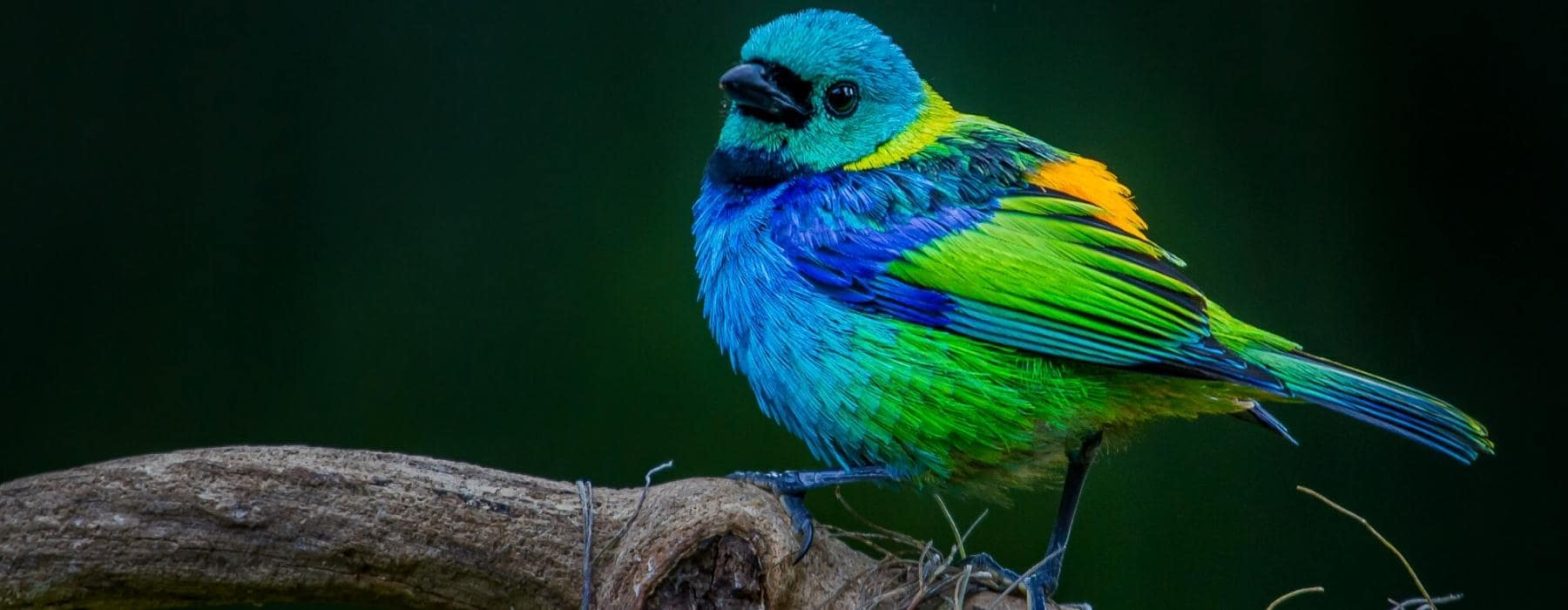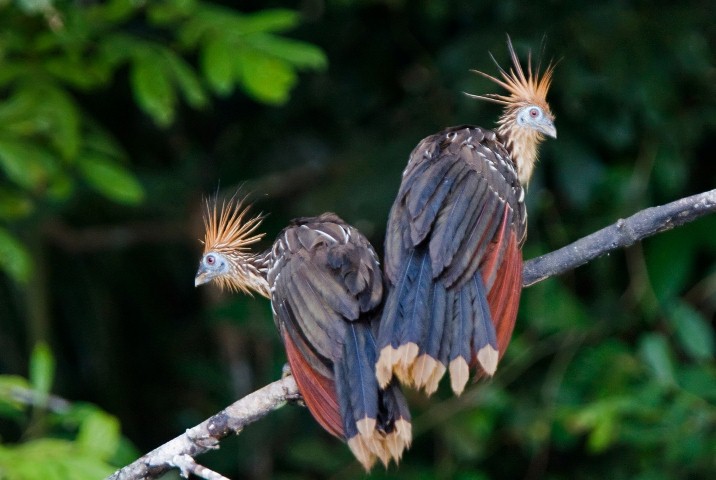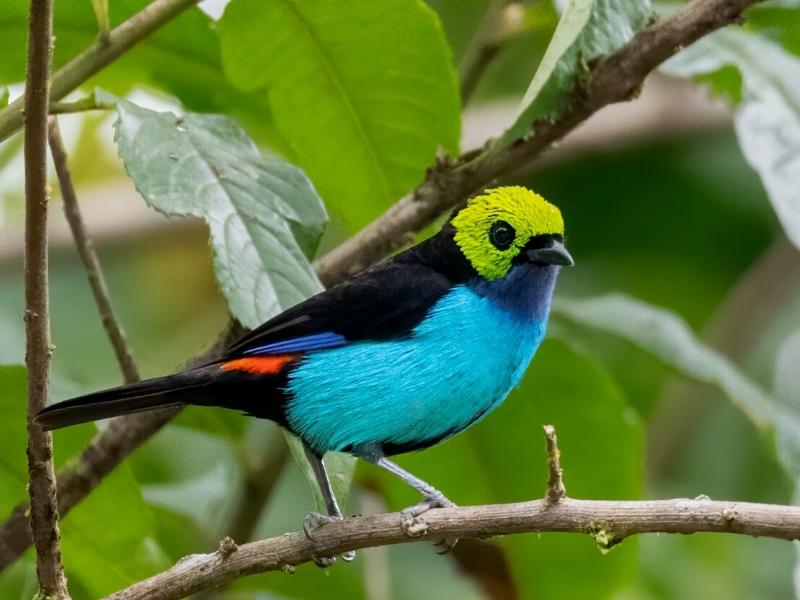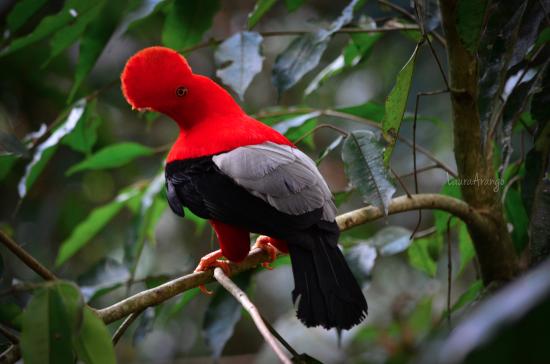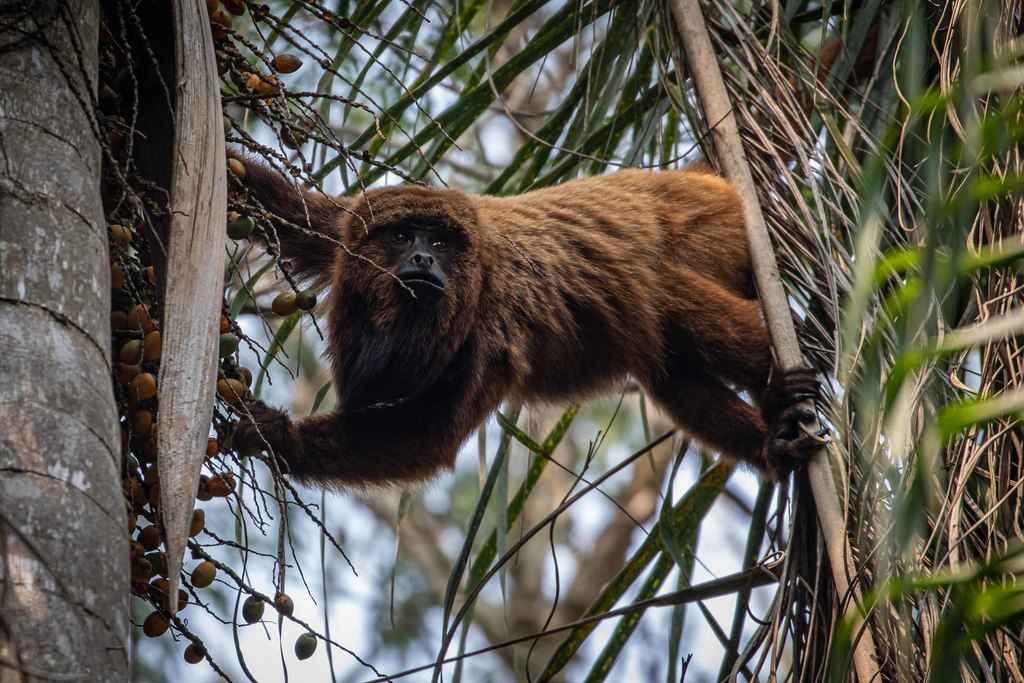Amazon Travel 26 days
Travel Day 01: Cusco to Bird waching Huacarpay .
We depart from Cusco around 04:30 a.m. arriving at Lake Huarcarpay 30 minutes later. Here we take time and spend the entire day observing highland lake and marsh birds amazon travel . The best is to follow the road that goes around the lake and start seeing most of the waterfowl typical of Andean wetlands including grebes, ducks,
gallinules and coots.The wet grasslands in front of the marsh are good for shorebirds and Andean Negrito. We can look for occasional migrants such as the Hudson Ian Godwit (rare) and Baird’s Sandpiper. The many- colored Rush- Tyrant and two endemic, the Rusty- fronted Canastero that can be seen around the ruins on the hillside above the
Lake and a spectacular hummingbird, the Bearded Mountainner. Overnight at the Lodge.
Travel Day 02: Huacarpay to Pumachaca Ranch – Amazon Travel
After a brief morning walk at the lake, we continue to the interesting tombs of Ninamarca, commonly known as “Chullpas”. We continue to Paucartambo, a picturesque Spanish colonial town, and then to Pumachaca Ranch though a beautiful narrow road and semi-humid montane scrub where a Taczanowski’s Tinamou has been
reported here.Common to see around Pumachaca are: White-rufted Sunbeam, Creamy-crested Spintail, Cinereous Conebill, Torrent Duck. Relax this night in the Chimney and spend the night at the comfortable accommodations.
Travel Day 03: Amazon Travel Pumachaca to acjanaco Cloudforest.
After early wake up and walk around the interesting trails, we continue up to Acjanacu pass with its elfin forest marks the beginning of the Cultural Zone of Manu Biosphere Reserve. Birders stay the night here because it is possible to see White-browed chat-tyrant, the Chestnut-breasted mountain-finch, Puna Thistletail, Paramo Pipit,
Diademed Tapaculo, Puna Tapaculo, Masked flowerpiercer, Golden- MANU NATURE PARK OPERATOR colared Tanager, Drab hemispingus and small mixed flocks with among others. Overnight camping.
Travel Day 04: Amazon Travel Manu Park to acjanacopass and Pillahuata .
This day we wake up even more early than we used to and have the chance to watch the “seven sunrise”, an impressive optical illusion that occurs during dry season and then walk down to Pillahuata site located in upper montane humid forest also known as the Coshnipata Valley where the bird species are quite different from
Acjanacu. There are basic camping areas that birders use. To stay the night here will be very rewarding as it’s possible to see many different species of birds such as the Hooded Tinamou, Stripe faced Wood-Quail, Golden plumed parakeet, Yuungas Pygmy-Owl, Gould’s Inca, Blue-banded Toucanet, Crimson -mantled Woodpecker,
Sierran Elaenia, White-collared Jay, Mountain Cacique, etc….Overnight camping.
Travel Day 05: Amazon Travel Pillahuata to San Pedro Cloud forest .
Again, early in the morning after breakfast, it is the best simply to bird your way slowly along the road. There will be plenty of activity, specially at down, with several specialties to look for. After the first tunnel, we stop at the mixed bamboo patch on the left and try for Rusty-breasted Ant pitta, and the endemic Red-and White ant pitta,
which is often quite vocal in the morning. At the second tunnel the vegetation becomes more luxuriant, look for the Chestnut-bellied Mountain Tanager, Tawny-rumped tyrannuler, Band-tailed Fruit eater and the barred Fruit eater in the mixed flocks, as well as Gray breasted Mountain Tucan. One bird to look out for in mixed flocks is the
vividly-colouder Ochraceous-breasted Flycatcher and the same thing for the spectacular Greater Scythe bill. Overnight in Orquideas cloud forest lodge
Travel Day 06: manu Park to San Pedro (Cloud Forest ) . Amazon Travel Peru .
Here, a thick cloak of clouds provides perpetual humidity and makes an ideal habitat for epiphytic plants such as bromeliads. This varied and fascinating world is home of the Cock of the Rock, Spectacled Bear, Orchids, Tree Ferns (one of the oldest living plants), mosses and lichens. This cloud forest exists between 2,000 and 3,500 m.a.s.l., and
at least 50% of the plant species found here are endemic to this region. Today we wake up very early to observe the Cock of the Rock (Rupicola peruviana), Peru’s national bird from a platform. The male birds are a vibrant reddish orange, and as many as several dozen come together for an exhibition of a mating ritual dance in a place called Lek.
The males display their crest, showing off and posturing for the females. The females, fewer in number, watch to select the most suitable males. After breakfast spend the entire day birding walking on the road.
Travel Day 07: San Pedro (Cloud forest ) Rainforest Amazon Travel .
The Manu road provides one of the best opportunities in Peru to bird upper tropical forest. Many of the most interesting and sought-after birds in the Manu road occur in this zone from about 900 – 1,700m.a.s.I. We have to concentrate on the good lower montane forest along the road, looking for mixed folks of brilliant-spotted Hummingbirds.
The Peruvian Pied tail is common to see. This day we spend all day birding and we hope to see Andean and White- eared solitaires, the Green Jay, the Blue-banded Toucanet, the Yungas Manakin, the astonishing Versicolored Barbet and arrange of tanager species. Overnight at Orquideas cloud forest lodge.
Travel Day 08: San Pedro Cloudforest to Peruvian Amazon travel .
As our lodge is very close to the Cock-of-the-rock Lek, we are able to visit it again and try to spot one of the females hidden in the forest. Free day to walk and bird along the road.
Travel Day 09: San Pedro Cloud forest Lodge .
As we continue our journey to lowlands, we stop in Patria where the cattle pleasure’s and secondary forest are good for seedeaters and other open habitat species of birds as the Orange-breasted Falcon, Military macaw, green-fronted lance bill, golden-collared honeycreeper and others. Atalaya overlooks is outstanding for viewing macaws.
From Atalaya port, we board our covered, motorized canoe and head down the Alto Madre de Dios River until Erika Lodge, where we will have the opportunity to walk through the interesting trails. Overnight at the lodge.
Travel Day 10: Cloud Forest Lodge in Manu Park .
This lodge is situated in the transition zone of the Andean foothills and the lowland rainforest. It has many more species of hummingbirds then is normally present in a rainforest lodge. Among 30 species of hummingbirds on their list is the endemic Rufus- webbed Brilliant. Here we find the Rufus -vented Ground Cuckoo, the gray-necked
woddrail, Blackish rail and Rufus-sided cracked. Close to a small lake there are Purple Gallinules, Hoatzins, Lesser kiskades and occasionally Pygmy Kingfishers and sun grebes. After lunch we follow an interesting trail, going up to the ridge at 1000 m.a.s.l. where we encounter mixed bird flocks. This higher area is also home of the emerald
toucanet , ornate flycatcher, orange fronted plush crown and the uncommon tawny-faced gnat wren, umbrella bird among others. Currently there exists an ongoing research project to quantify the numbers of peccaries and tapirs visiting the mammal clay lick (collpa) at Erika Lodge. We are creating an identification field guide for every
individual mammal that visits the clay lick. The methods of identification utilize individual characteristics and the unique scars on skin and ears. Our goal each night that we visit the tapir clay lick is to identify each individual that visits the clay lick or collpa. Our observations will aid the data set to eventually determine territory use, visitation
frequency, seasonal variation, and human visitation influence.
Travel Day11: Cloud Forest Lodge.
This day we will get up very early to board our boat, and after five minutes, we will arrive to a Parrot Lick “Collpa”, which is a wall of clay in the riverbanks, where many species of parrots such as the blue headed parrot, white-eyed parakeet, feed for mineral and salt supplements to their diet of seeds and fruits. After this we spend the day, as we
bird the trails, remember that this site gets birds from the lowlands like the Amazonian Streaked-Ant wren, as well as some species typical of high elevations.
THE PUSHARO PETROGLIFES INTRODUCTION:
Located at the right side of the Sinkibenia River, in the Pantiacolla range of Manu National Park, Madre de Dios, Southern Peru. There is not much information found about the ancient inka civilization of the Antisuyo, jungle part of the Tahuantinsuyo Empire. The first information about the Pusharo Petroglyphs’ is from the religious missioners
and explorers. In 1921 the Dominic Priest Vicente de Cenitagoya was the first person in Pusharo Petroglyphs’ and the first one drawing all the symbols. The rock has 27 meters long per 2 meters tall of with different icons: naturalists or realistic, geometric, morphologic and abstract drawings. The drawings where made by using stones
and hummed sand by people of the Matshiguenka ethnia. All are painted with “Genipa americana” (huito) – black/blue colour and with Bixa orellana – (achiote) a reddish colour. At the moment the close native communities still visit the site and re-paint the drawings every now and then as an ancestral tradition and they prefer not to talk
about the meaning of them.
Travel Day 12: Cloud Forest Lodge .
The altitude of this Private Reserve ranges between 600 to 1,150 m.a.s.l. (1200 to 3450 feet) encompassing different habitats. This altitude range explains the high diversity of wildlife found around this area between high and low jungle, so immediately after breakfast, we will start walking through the interesting trail system.
Erika is one of the pioneer lodges located in the tropical rainforest of the Cultural Zone of Manu National Park used in the past by expeditions in search of the lost golden city of the Inkas “Paititi”. Overnight in the lodge.
Travel Day 13: Cloud Forest Lodge to Pusharo .
This day we board our covered, outboard motor boat and head down the Alto Madre de Dios river for approximately 2 hours toward the native community of Llactapampa After a brief walk in the community we will
continue in our boat to the confluence of the Alto Madre de Dios River and the Palotoa River where we are going
to camp this night in a beach and get ready for next day morning rude hike. Waking up early in the morning, after having breakfast and packing up the camp, we start our 9 hours walk along the Palotoa’s shore and the river itself
because of the unexplored and dense vegetation of the zone. After the first hour we will arrive to the first
Matshiguenka community, ask for their permission to enter their territory and meet the rest of the expedition team: native guide and porters (if required). After this we continue our walk toward the Palotoa Teparo
Community, the entrance door to the Petroglyphs’. During this hike it is possible to observe the immensity of the
rainforest and the diversity of birdlife, caimans, and tortoise. Etc . After our box lunch, we continue walking in the inner forest until we finally arrive the mysterious Pusharo Petroglyphs’. Set up our campsite.
Travel Day 14: Amazon Travel to Pusharo Manu Park
We have the entire day to observe the icons, talk about them with our guide, take pictures and walk around the site and observe flora and fauna of the area and the surrounding forest.
Overnight in the base campsite.
Travel Day 15: Amazon Travel to Pusharo Rainforest Lodge
Immediately after getting ready for the return, we walk down through the trails to the natural pools of the river, where we can spend a while swimming, relaxing and having lunch. Early afternoon we arrive to the Palotoa native
community and hold a farewell reunion with the native guides and the porters. We walk back to the Alto Madre de
Dios River where our motor boat will be waiting for us to go downstream the Alto Madre de Dios River and observe rives species of bird life such as the Roset Spoonbill, Egrets, etc. toward Yanayacu Reserve strategically
placed at the last Andean foothills has a great diversity of habitats. The rarely seen Peruvian Recurve bill and
Dusky- tailed Flat bill are seasonal and August and September seems to be a good time to see them. Overnight at the lodge.
Travel Day 16: Amazon Travel Shintuya – Native Community .
Early morning after breakfast we board our canoe for the four-hour trip down the Alto Madre de Dios River to Shintuya native community from the Matshiguenka ethnic and have a visit talking to the resident families, after
sharing lunch with them we set up camp and enjoy a friendly bonfire. Very early and after registering in the official
tourist logbook at Limonal, the Park Rangers Headquarters and eating an early breakfast, we follow the Manu River until we arrive Salvador Lake, our base safari campsite (screened double rooms, dining room, bathrooms,
radio communication is available). This canoe ride gives us the opportunity to observe the immensity of the
rainforest and the diversity of birdlife, reptiles and mammals. You will often see animals sunning themselves on beaches, or foraging for food in the trees lining the riverbanks. We arrive early in the afternoon and have lunch
before setting off on a jungle trail. Our time is spent looking for wildlife inside the rainforest and on Salvador
Oxbow Lake, until the sun goes down and we return to camp. We explore Salvador Lake by paddling quietly along on a catamaran, giving us the opportunity to observe unique species of birds, monkeys, caimans and with luck the
Giant Otter (Pteronura brasiliensis). This endangered species can be seen swimming, fishing, eating and playing.
Travel Day 17: Manu National Park to Salvador Lake
We rise early in the morning, as the forest is awakened by the Red Howler monkey (Aloatta seniculus) declaring its territory. A morning walk before breakfast is a great way to catch wildlife in the pursuit of food, as the temperature
is very pleasant at this time of day. The 20 minutes’ walk from the river to the lake takes you through a nice terra
firmer forest. The epigone trail around the lake has a good selection of bird species where we should be looking for the range-restricted black-faced Cotinga. Overnight in the safari campsite.
Travel Day 18:Manu National park to Salvador – Otorongo Lake .
Very early we visit Salvador Lake because birding from the catamaran while been paddled around the lake makes for a very pleasant and memorable birding experience with all of the lake specialties possible: Agami heron,
Slender-billed Kite, Pale-eyed Blackbird, and Long- crested Pygmy tyrant, Hawk-Eagle, Hairy-crested Ant bird,
purple- throated Cotinga and many others. After relaxing we cross the river to walk an 8-km trail to another oxbow lake called Otorongo. A strategically located observation tower rises 15 meters above the lake and the jungle
floor, giving us more chances to observe wildlife including the Giant Otter. Overnight in the safari campsite.
Within the Park, Pakitza claims some of the most extensive bamboo patches and therefore holds an almost complete set of bamboo specialist, Pakitza is a guard post at the entrance of the restricted area of the park. It is
possible to see species of birds such as the Painted parakeet, Black-Capped Parakeet Mottled Owl, Lined Forest
Falcon, Inhering’s Ant wren, Manu Ant bird, and many others. Beck to Salvador before the sunset. Late in the afternoon we will use the catamaran and with the help of flashlights we can observe the black caimans rise from
the depths of the lake and begin their search for prey. Return to the campsite.
Travel Day 19 : Salvador Lake to Boca Manu
Once again we wake up early, enjoy a brief morning walk and eat breakfast, then pack up camp and go downstream the interesting Manu River. We arrive at Boca Manu midday, this village is situated a short distance
from the confluence of the Manu and Alto Madre de Dios rivers. Hikes around the trail system of Boca Lodge.
Overnight at the Lodge.
Travel Day 20: Manu National Park to Boca Manu .
This day we visit an island that belongs to a native family and walk around the lake and observe all the bird life. We spend the entire day searching for birds species around the lodge. Overnight at Boca Lodge.
Travel Day 21: Blanquillo Macaw Clay Lick .
After a very early wake up, we board a camouflaged catamaran and go down the river to the “Collpa” macaw lick. We quietly observe the various parrots feeding on the clay for mineral and salt supplements to their diet of seeds
and fruits. The brightly colored macaws usually wait patiently in the surrounding trees until the smaller parrot
species have left the area. Slowly, the macaws come down to the clay wall to feed. We need a lot of patience and silence on the catamaran so as not to disturb them as they eat the clay. During the afternoon we start walking on
the interesting trails of the Lodge where we can see Jacamars, many different species pf hummingbirds, the
Crimson- crested Woodpecker, tanager such as the paradise, the screaming Piha and many others. Overnight at the Lodge. This day we will use a strategically located observation tower rises 46 meters above Camungo Lake and
the jungle floor, giving us more chances to observe wildlife i ncluding the Giant Otter and many different species
of birds that are common to this altitude of the canopy such as macaws, toucans, wood creepers, woodpeckers can be observed flying near this platform. Enjoy the spectacular view with large canopies from a tall Kapok tree with a
360 degree view. A night birding can be productive with Great Potoo, Common Potto and even Long-tailed Potto.
Overnight at the Lodge.
Travel Day 22: Manu Park Blanquillo Macaw Clay Lick – Colorado Amazon Travel to Puerto Maldonado
This morning we have a second chance to visit the macaw clay lick before packing our luggage and setting off again on our motorized boat toward Colorado village and then by bus to Puerto Maldonado. Overnight in a Lodge.
Travel Day 23: Puerto Maldonado – Sandoval Lake .
Transfer from Puerto Maldonado airport to the river port on the Madre de Dios River. A 25 minutes journey down the Madre de Dios River by motor canoe brings you to the end of the trail in to Sandoval Lake Lodge. From here
the trail takes you on a 2-mile walk/or rickshaw ride through secondary forest, until we reach a small canal where
we board canoes and are paddled 220 yards through a flooded forest of 100-foot tall Mauritia palms. As the canal opens onto the shimmering surface of the lake, we transfer to a catamaran and are leisurely paddled across half
the lake to the lodge. After lunch and a brief rest to avoid the early afternoon heat, we once again board the
catamaran and set off to explore the entire west end of the lake. Here, in the flooded palm forest we drift to the sounds of hundreds of Red-Bellied Macaws as they return to the palm forest for the night. We return to the lodge
around nightfall for dinner. After dinner we will return to the canoes to look for the large and extremely rare Black
Caimans. If it is a clear starlit night, we will also be able to float in the middle of the lake and marvel at the brilliance of the sky.
Travel Day 24: Sandoval Lake .
A pre-dawn wake-up call will enable us to be on the lake for sunrise and a hopeful encounter with the family of Giant Otters which frequent the lake and are most active at this time of day and long walk night walk
Travel Day 25 :Sandoval Lake Macaw palm Tree .
We get up early to go see the Lick palms this is a special place within the reserve where different species of parrots and macaws gather to eat the dried palms that are rich in minerals such as calcium, sodium, potassium, etc. Which
is very important for the digestion of the birds? Then return to the lodge for breakfast. Then we prepare to leave
the national reserve tambopata “Sandoval lake” to return to our lodge in the Madre de Dios River, where we will catch our boat to take us, after settling into our comfortable lodge, and lunch, climb a tower 27 meters tall,
comfortably climb the tower, which will allow us to reach a suspension bridge, and the launch pad of drawing
pens, cross the first bridge over the trees of 89 meters in length rising to a height of 37 meters among the main branches of an ancient tree, great opportunity to see animals that are impossible from the ground, an
unforgettable experience, then the guide over and attendees will prepare us to feel pure adrenaline,
using all attachment security will make a slip for cable and we feel like a bird flying over the forest, over 190 meters in a few seconds.
We guarantee 100% security, fun and lots of adrenaline produced by the adventure. Dinner and overnight in our comfortable lodge on the banks of the River Mother of God.
Travel Day 26 : Back to Puerto Maldonado .
After breakfast, we will travel by motorized canoe to Puerto Maldonado “Office” coordinating the flight time and / or bus can stay in the office departure time of your flight or bus.













